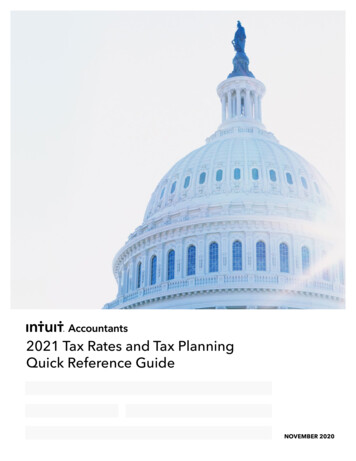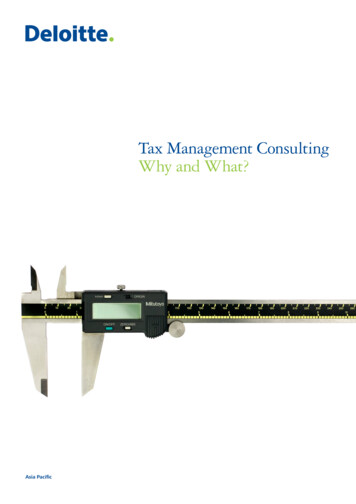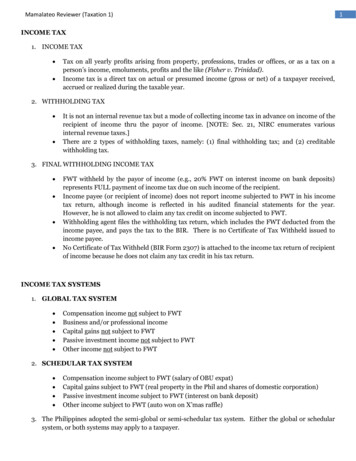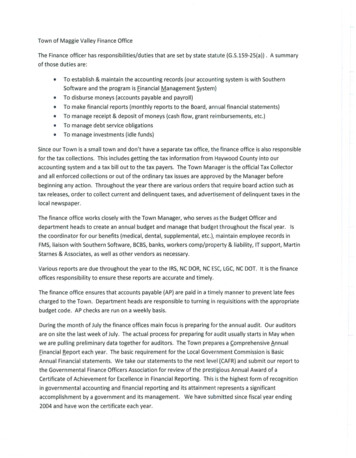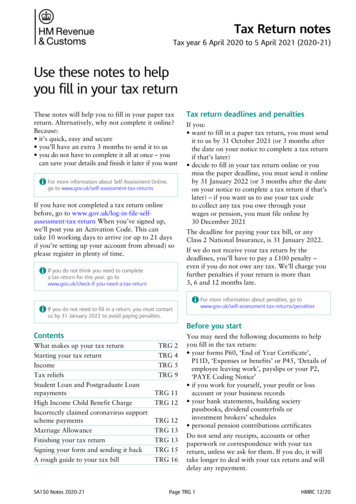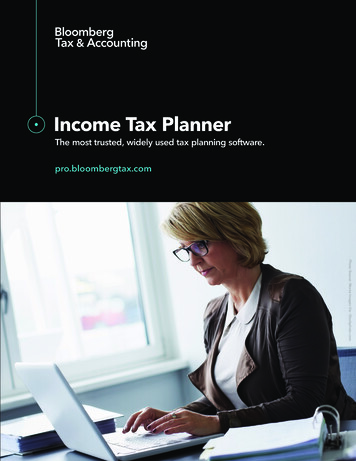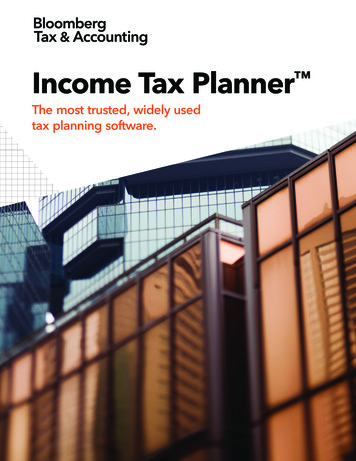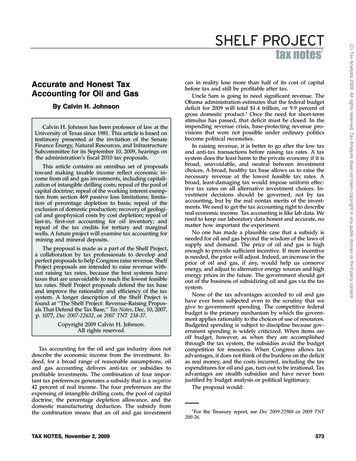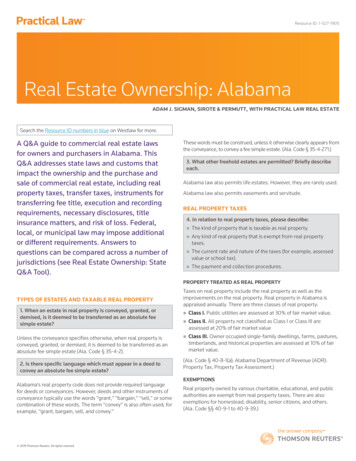
Transcription
California Property TaxAn OverviewPUBLICATION 29 DECEMBER 2018BOARD MEMBERS (Names updated October 2019)TED GAINESFirst DistrictSacramentoMALIA M. COHENSecond DistrictSan FranciscoANTONIO VAZQUEZThird DistrictSanta MonicaMIKE SCHAEFERFourth DistrictSan DiegoBETTY T. YEEState ControllerBRENDA FLEMINGExecutive Director
PREFACECalifornia Property Tax provides an overview of property tax assessment in California. It is designed to givereaders a general understanding of California’s property tax system. The publication begins with a brief historyof Proposition 13, which since 1978 has been the foundation of California’s property tax system. It then discussesthe roles of key players in property tax assessment—California voters, the Legislature, the California State Board ofEqualization (BOE), and county assessors. It explains which types of property are subject to taxation and which areexempt. It addresses the issue of where property should be assessed. It discusses the annual process of preparingthe property tax rolls, the procedure for challenging an assessment, and the process for collecting property taxes.Although this publication is periodically updated, the laws and rules concerning property tax assessment arecontinually modified. Therefore, we caution you to consult appropriate sections of the Revenue and TaxationCode and related codes and property tax regulations in order to have the most current information.We welcome your suggestions for improving this publication. Please call 1-916-274-3350 or send yoursuggestions to:County-Assessed Properties Division, MIC:64California State Board of EqualizationPO Box 942879Sacramento, CA 94279-0064If you need more information about California property tax, visit us at www.boe.ca.gov. Our website has the completetext of the Assessors’ Handbook sections, special topic and assessment practices surveys, the Property Taxes Law Guide,Property Tax Rules, Annotations, Letters To Assessors, guidelines and procedures, issue papers, and other publications.In addition, you will find a listing of the addresses and telephone numbers for county assessors’ offices and answers tothe most frequently asked questions about property tax issues, and you can find current information on property taxprojects and Board meeting dates. The website also contains a calendar of property tax dates.Note: This publication summarizes the law and applicable regulations in effect when the publication was written, asnoted on the cover. However, changes in the law or in regulations may have occurred since that time. If there is anyconflict between the text in this publication and the law and/or regulations, the latter are controlling.To contact your Board Member, see www.boe.ca.gov/members/board.htm.
CONTENTSChapterPageThe Background of Property Taxes in California1The Role of Voters and the Legislature2The Role of the California State Board of Equalization2The Role of the County Assessor5Taxable Property6Property Tax Exemptions7Other Property Tax Relief Measures8Where Property is Taxed10The Assessment Process10The Appeal Process—Local Equalization11Tax Collection12Glossary of Property Tax Terms14For More Information16
IMPORTANT PROPERTY TAX DATES (2018)January 1Lien date for all property.February 15Legal deadline for filing most exemption claims.Last day to file a timely exemption claim for cemeteries, colleges, exhibitors, free publiclibraries, free museums, public schools, and churches.Last day to file a timely exemption claim for veterans, disabled veterans, andhomeowners.Last day to file timely exemption claims for welfare and veterans’ organizations.April 10Last day to pay second installment of secured taxes without penalty.July 1Deadline for county assessor to complete local assessment roll.July 2–September 15 orNovember 30Taxpayers file applications for reduction in assessed value with clerk of countyboard of supervisors.August 31Last day to pay unsecured taxes without penalty.December 10Last day to pay first installment of secured taxes without penalty.Last day to file an exemption claim for homeowners and veterans to receive 80 percentof the exemption.Last day to file an exemption claim for disabled veterans to receive 90 percent of theexemption.
THE BACKGROUND OF PROPERTY TAXES IN CALIFORNIAPrior to 1912, the state derived up to 70 percent of its revenue from property taxes. The state no longer relies onproperty taxes as its primary source of funds—since 1933, the only property tax directly levied, collected, andretained by the state has been the tax on privately owned railroad cars. Currently, the state’s principal revenuesources are personal income taxes, sales and use taxes, bank and corporation taxes, and a series of excise taxes.Today, it is California’s counties, cities, schools, and special districts that depend on the property tax as a primarysource of revenue. The property tax raised more than 62.1 billion for local government during 2016-17. Thesefunds were allocated as follows: counties 15 percent, cities 12 percent, schools (school districts and communitycolleges) 54 percent, and special districts 19 percent.Proposition 13On June 6, 1978, California voters overwhelmingly approved Proposition 13, a property tax limitation initiative. Thisamendment to California’s Constitution was the taxpayers’ collective response to dramatic increases in propertytaxes and a growing state revenue surplus of nearly 5 billion. Proposition 13 rolled back most local real property,or real estate, assessments to 1975 market value levels, limited the property tax rate to 1 percent plus the ratenecessary to fund local voter-approved bonded indebtedness, and limited future property tax increases.After Proposition 13, county property tax revenues dropped from 10.3 billion in 1977-78 to 5.04 billion in1978-79. As a result, many local governments were in fiscal crisis. Keeping local governments in operation the firsttwo years following Proposition 13 required legislative “bailouts” to offset property tax revenue losses. A first-yearstopgap measure costing 4.17 billion in state surplus funds was necessary to directly aid local governments. Asecond-year bailout, a long-term fiscal relief plan, cost the state 4.85 billion.Prior to 1978, real property was appraised cyclically, with no more than a five-year interval between reassessments.Since property values were systematically reviewed and updated, assessed values were usually kept at or nearcurrent market value levels. In contrast, under Proposition 13, properties are reassessed to current market valueonly upon a change in ownership or completion of new construction (called the base year value). In addition,Proposition 13 generally limits annual increases in the base year value of real property to no more than 2 percent,except when property changes ownership or undergoes new construction. Essentially, Proposition 13 convertedthe market value-based property tax system to an acquisition value-based system.Disparities in Assessed ValueUnder Proposition 13, similar properties can have substantially different assessed values based solely on thedates the properties were purchased. Disparities result wherever significant appreciation in property values hasoccurred over time. Longtime property owners, whose assessed values generally may not be increased more than2 percent per year, tend to have markedly lower tax liability than recent purchasers, whose assessed values tend toapproximate market levels.Court Challenges to Proposition 13Immediately after Proposition 13 passed, its constitutionality was challenged. The California Supreme Court upheldthe constitutionality of Proposition 13 in Amador Valley Joint Union High School District v. State Board of Equalizationon September 22, 1978. The decision rendered in this case remained the highest judicial ruling on Proposition 13until 1992, when the United States Supreme Court ruled, in Nordlinger v. Hahn, that Proposition 13 did not violatethe equal protection clause of the United States Constitution. This ruling effectively ended speculation aboutwhether the judicial system would ever overturn or modify Proposition 13.DECEMBER 2018 CALIFORNIA PROPERTY TAX1
THE ROLE OF VOTERS AND THE LEGISLATURETogether, the electorate and the Legislature of California have reshaped the administration of property taxes since1978. Constitutional amendments, both voter-initiated (initiative constitutional amendments) and Legislatureinitiated (Assembly or Senate constitutional amendments), have established fundamental changes. Meanwhile,legislative measures have interpreted, clarified, and implemented the constitutional provisions.THE ROLE OF THE CALIFORNIA STATE BOARD OF EQUALIZATIONThe BOE was established in 1879 by constitutional amendment. The BOE consists of five elected members: fourmembers are elected from legislatively defined districts, while the fifth member, the State Controller, is electedat-large and serves in an ex officio capacity. The BOE’s original purpose was to regulate county assessment practices,equalize county assessment ratios, and assess properties of railroads. Over the years, the legislature expandedthe Board’s duties to include many tax and fee programs. In 2017, the Taxpayer and Transparency Act (AB102),restructured the BOE into three separate agencies. Most of the duties performed by the BOE were transferred to theCalifornia Department of Tax and Fee Administration and the Office of Tax Appeals.The BOE continues to perform the duties it was assigned by the state constitution, including the administration ofmost property tax programs.The Need for Uniform AssessmentsWhile the county assessor determines the value of locally assessable property for taxation purposes, the BOE hasa vested interest in the valuation by virtue of its constitutional responsibility to promote uniformity in propertyassessments throughout the state. Uniformity is important both within and among counties for a number of reasons: Cost-sharing provisions for funding public schools require the state to make up the difference betweenstatutory revenue guarantees and property tax proceeds. Underassessments increase a required state subsidyfrom the general fund. Assessments at more or less than full taxable value result in a misallocation of revenues.The BOE’s Property Tax DivisionsThe BOE’s property tax functions are administered by two divisions: County-Assessed Properties Division andState-Assessed Properties Division. Each division’s role in the administration of property tax is described on thefollowing pages.County-Assessed Properties DivisionThe County-Assessed Properties Division is responsible for both establishing policies and standards for properassessment practices statewide and measuring statewide compliance and uniformity in county assessmentprocedures and practices. These accomplishments are achieved through the following activities.Assessment Practices SurveysThe Government Code requires the BOE to periodically review the practices and procedures (surveys) of specifiedcounty assessors’ offices. The purpose of the survey is to determine the adequacy of the procedures and practicesthe county assessor uses in valuing property and to evaluate the assessor’s performance of mandated duties. Thesurvey concentrates on statutory mandates and revenue-related issues.The surveys are conducted as follows: For each county, BOE staff conducts an audit of the assessor’s procedures andpractices. The staff then publishes an assessment practices survey report that summarizes the findings and includesrecommendations for improvement.2CALIFORNIA PROPERTY TAX DECEMBER 2018
In addition, each year the BOE staff perform appraisal samples of specified county assessment rolls. In each case,a statistically representative sample is drawn from the county assessment roll. BOE staff audits and appraiseseach property in the sample and compares the results to the assessor’s values. Staff then expands the results todetermine whether the total assessment roll complies with statutory standards.Special Topic SurveysThe BOE periodically publishes “special topic” surveys on statewide assessment practices. The surveys focus onspecific subject areas or major issues that have significant impact on local property taxation. These surveys areconducted when needed. To date, surveys have been conducted on Land Conservation Act (Williamson Act)properties, new construction, changes in ownership, mobilehomes, possessory interests, assessment appeals, auditprocedures, confidentiality of assessors’ records, depreciation factors, coordination on tenant improvements, andsection 11 and PERS properties.Property Tax RulesThe Board is required to prescribe rules and regulations to govern assessors and local boards of equalization. TheBOE’s property tax rules are codified in Title 18 of the California Code of Regulations. These rules are adopted toclarify statutes relating to assessment principles and procedures.Assessors’ HandbookThe Assessors’ Handbook comprises more than 25 instructional manuals on various assessment and appraisal topics,including annually revised building cost estimating guidelines. Individual manuals are periodically updated toreflect legislative changes and revisions in appraisal and assessment systems.Property Tax ExemptionsThe BOE prevents multiple claims for the Homeowners’ Property Tax Exemption and the Disabled Veterans’Exemption, by acting as a statewide clearinghouse. The BOE also has a dual role with county assessors inadministering the Welfare Exemption, which exempts property used exclusively for religious, hospital, scientific, orcharitable purposes and owned and operated for those purposes by qualifying nonprofit organizations. The BOEdetermines whether an organization is eligible for the Welfare or Veterans’ Organization Exemption. The BOE alsoadvises assessors and prescribes forms for the administration of all other property tax exemptions.Appraiser Training and CertificationCounty assessors and the property appraisers they employ must meet certain minimum qualifications and holdan appraiser’s certificate issued by the BOE which is attained by successfully passing a certification examination. Inorder to retain an appraiser’s certificate, appraisers must complete a specified number of hours of training per year.The BOE provides training at various sites throughout California and monitors the yearly training requirements. TheBOE conducts classes on various appraisal topics. In addition, the BOE provides workshops, online sessions, andwebinars on specific assessment issues to enhance the knowledge and skills of county assessors, appraisers, BoardMembers and their staff, and appeals board members.Letters to AssessorsLetters to Assessors are advisory letters issued to all county assessors and interested parties. Typically, the lettersprovide staff interpretations of rules, laws, and court decisions, or general information relating to property taxassessment. A no-cost email subscription service for Letters to Assessors is available BER 2018 CALIFORNIA PROPERTY TAX3
Assessment ServicesThe BOE also responds to individual inquiries from assessors, legislators, taxpayers, and the business community,as well as to letters written to the Governor on property tax issues. To contact the BOE via email with property taxquestions, email PT-WebRequests@boe.ca.gov.Legal Entity Ownership ProgramThis program is a cooperative effort between the BOE and the Franchise Tax Board to discover both changes inownership and change in control of legal entities. When the BOE determines that an entity that owns real propertyin California has undergone a change in control or ownership, the BOE informs the appropriate assessors of theneed to reappraise real property owned by those entities.Clearinghouse ProgramsThe BOE monitors claims for relief under Propositions 58 (parent-child transfers) and 193 (grandparent-grandchildexclusion), Propositions 60 and 90 (persons over 55) and 110 (disabled persons), and Proposition 3 (eminentdomain properties).FormsThe BOE prescribes many types of forms for use by assessors, such as business property statements, exemptionclaim forms, and change in ownership forms. Assessors may make limited revisions to the forms to meet theirprocessing needs, but they must submit such revised forms for BOE staff review and approval.State-Assessed Properties DivisionThe State-Assessed Properties Division is responsible for administering the assessment program of Californiastate assessees under the BOE’s jurisdiction.State AssesseesThe California Constitution requires the BOE to annually assess property (except franchises) owned or used byregulated railway, telegraph, or telephone companies, car companies operating on railways in the state, andcompanies transmitting or selling gas or electricity. It also requires the BOE to annually assess pipelines, flumes,canals, ditches, and aqueducts lying within two or more counties. Except for the railway car companies (see PrivateRailroad Car Tax below), the assessed values are allocated to the counties and other local tax jurisdictions in whichthe property is located. The taxes are levied and collected in the same manner as they are for county-assessedproperties. State-assessed property is not subject to the provisions of Proposition 13 and is assessed at itsfair market value, or its full value, as of 12:01 a.m. each January 1.Private Railroad Car TaxThe BOE performs the entire assessment function, including appraisal and tax collection, for privately ownedrailroad cars.Tax-Rate Mapping ProgramA tax-rate area number is assigned to each geographical area in the state with a different distribution of revenuesamong taxing jurisdictions. The BOE maintains this program in order to allocate the value of certain state-assessedproperties to their appropriate taxing jurisdictions. County auditors also use these tax-rate areas to allocateproperty tax revenues to the appropriate taxing jurisdictions.4CALIFORNIA PROPERTY TAX DECEMBER 2018
Taxpayers’ Rights Advocate OfficeThe Taxpayers’ Rights Advocate, appointed by the BOE Executive Director, is responsible for implementing theMorgan Property Taxpayers’ Bill of Rights. The Advocate reviews, from a taxpayer’s point of view, how effectivethe BOE’s operating divisions and the county assessors are in providing clearly written informational materials toproperty taxpayers and in adequately resolving inquiries, complaints, and other problems. The Advocate is alsocharged with identifying areas of recurring conflict between taxpayers and property tax assessment officials. TheAdvocate issues a formal annual report on property tax matters affecting taxpayers’ rights. The BOE holds publichearings to address the report and related property tax issues.In addition, the Property Taxpayers’ Bill of Rights provides measures designed to promote the fair administration ofthe property tax. For example, section 5909 of the Revenue and Taxation Code provides for relief of penalties andinterest in some situations where a taxpayer relies on written rulings from the county assessor.Taxpayers’ Rights Advocate Office, MIC:120California State Board of Equalization450 N StreetPO Box 942879Sacramento, CA 94279-0120Telephone: 1-916-327-2217www.boe.ca.gov/traTHE ROLE OF THE COUNTY ASSESSORThe county assessor, an elected official, is governed by the California Constitution, the laws passed by theLegislature, and the rules adopted by the BOE. An individual county government does not control the countyassessor’stasks. 1Annual AssessmentsThe county assessor must annually assess all taxable property in the county, except for state-assessed property,to the person, business, or legal entity owning, claiming, possessing, or controlling the property on January 1. Theduties of the county assessor are to discover all assessable property, to in
Amador Valley Joint Union High School District v. State Board of Equalization on September 22, 1978. The decision rendered in this case remained the highest judicial ruling on Proposition 13 until 1992, when the United States Supreme Court ruled, i


